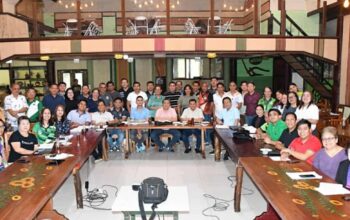
THE government’s premier community empowerment program through the Kapit Bisig Laban sa Kahirapan (KALAHI) Comprehensive Integrated Development of Social Services (CIDSS) will continue until 2023 despite a change in administration.
This was the statement issued by Department of Social Welfare and Development (DSWD) Cluster Head for Bohol and Siquijor, Sharon Escabarte, during the Regional Information Officers’ Conference with the Association of United Development Information Officers (AUDIO) in Bohol on June 9 at the Bluewater Resort in Panglao.
For Bohol, the cycle implements projects in 37 towns or 917 barangays, Escabarte said.
To date, the government has funded the completion of 74 sub-projects amounting to P776,094,200.
This is for the 192 sub-projects, of which 49 have been completed.
Towns in Bohol where the additional financing are implemented are Sevilla, Lila, Batuan, San Isidro, Danao, Dagohoy San Miguel, Alicia, Anda, and Bien Unido for group one.
The project will also be in Loon, Calape, Tubigon, Clarin, Inabanga, Buenavista, Getafe, Talibon, Trinidad, Ubay, Mabini, Candijay, Sierra Bullones, Duero, Jagna, Garcia Hernandez, Valencia, Dimiao, Bilar, Balilihan, Catigbian, and Carmen.
KALAHI-CIDSS is one of the poverty alleviation programs of the Philippine government implemented by DSWD.
It addresses the needs of poor communities by using a Community-Driven Development (CDD) approach, a globally recognized strategy for achieving empowered communities in target municipalities to improve access to basic services, as well as to participate in more inclusive local planning, budgeting, and implementation.
While KALAHI-CIDSS’ main thrust to empower communities through increased participation remains, an additional financing has been allotted in continuity of its programs for 2021 to 2023, Escabarte said.
The additional funding, however, is focused on addressing the effects of the COVID-19 pandemic and other disasters, while pursuing the institutionalization of the CDD principles of participatory, transparency, accountability, and inclusive growth in the local development planning, she explained.
For this, the project implementation involves two phases: harmonization and institutionalization.
Escabarte explained that harmonization entails unifying all efforts with the local planning process while using the Disaster Response Operations Modality in updating the existing Barangay Development Plan, while keeping in central focus the participatory disaster response and local community-owned planning.
The municipal orientation and enrolment can lead to the Municipal Disaster and Risk Reduction Management (DRRM) Council meeting, Barangay DRRM, and needs assessment and analysis sessions which should usher in the sub-project development.
The proposed sub-projects are then technically reviewed by the Municipal Inter-Agency Council which leads to the sub-project implementation and sub-project completion.
On its second year, the project should be under the institutionalization of the CDD in local planning and project implementation where the second sub-project preparation, execution, and assessment happen.
Drawing from the community planning implementation and experiences of year one, the community starts with a Barangay or Municipal DRRMC meeting, needs assessment and analysis and project development to respond to the analyzed needs. (RAHC/PIA7 Bohol)


